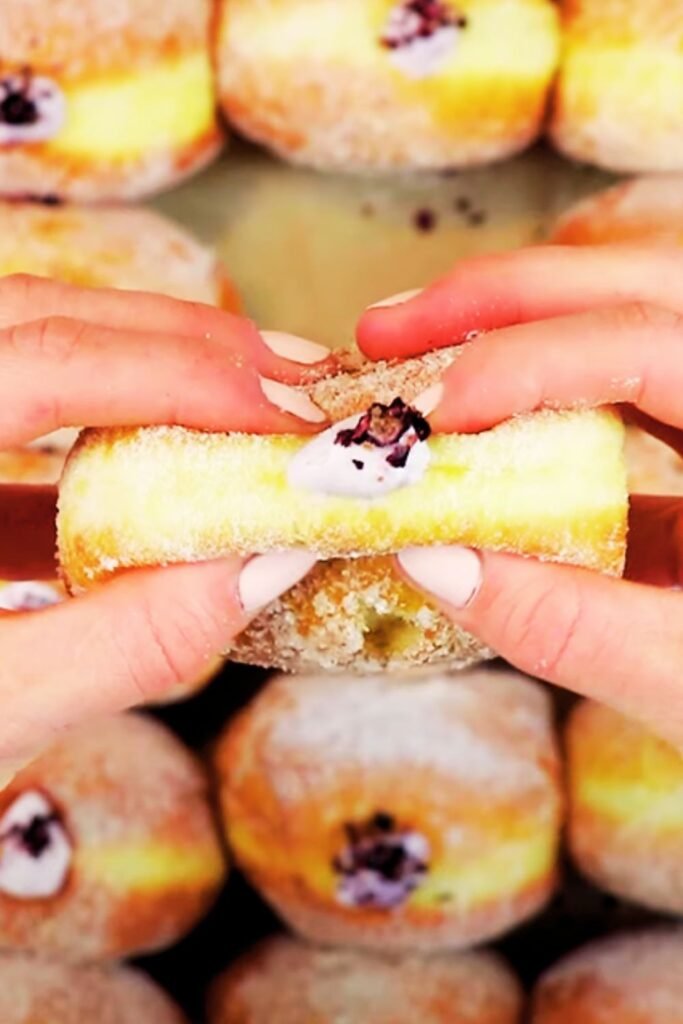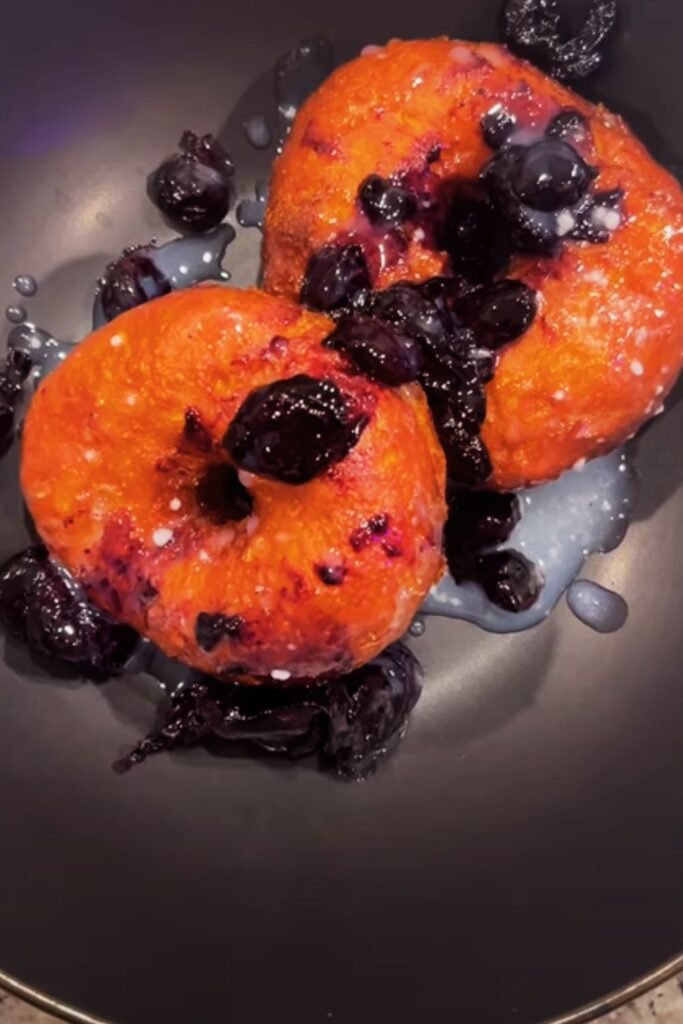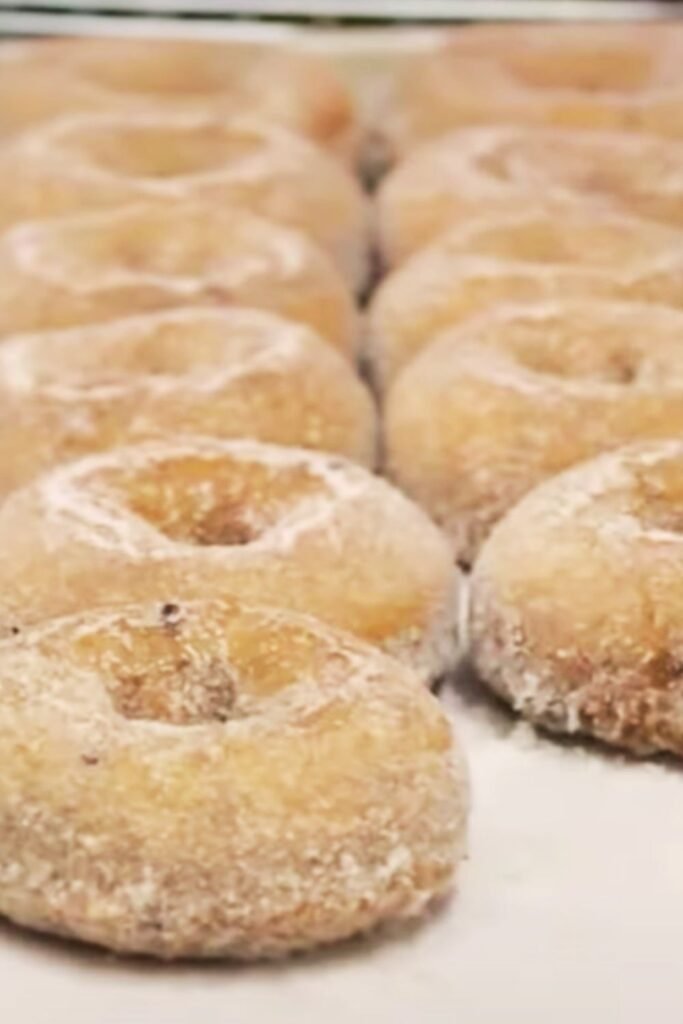When I first discovered the magic of stuffed cookies, my world changed completely. There’s something absolutely thrilling about biting into what appears to be an ordinary cookie, only to discover a surprise center that makes your taste buds dance with joy. Today, I’m sharing my absolute favorite creation: Big Blue Monster Stuffed Cookies that combine the beloved flavors of classic monster cookies with an unexpected twist that will have everyone asking for your secret.
These aren’t your grandmother’s cookies, though I’m sure she’d approve of the ingenious concept. My Big Blue Monster Stuffed Cookies take the traditional monster cookie foundation—that perfect blend of peanut butter, oats, and chocolate chips—and elevate it to an entirely new level with a creamy, indulgent center that creates an explosion of flavor in every single bite.

Understanding the Monster Cookie Legacy
Before diving into my stuffed version, let me explain what makes monster cookies so special in the baking world:
Monster Cookies : Large, chewy cookies packed with multiple mix-ins including peanut butter, oats, chocolate chips, and often M&Ms or similar candies
Stuffed Cookies : Cookies with a filling or center, typically made by wrapping cookie dough around a soft filling before baking
Big Blue Variation : My signature twist using blue food coloring and blue-themed mix-ins to create a visually stunning monster cookie
The beauty of monster cookies lies in their forgiving nature and endless customization possibilities. I’ve been perfecting this recipe for years, and I can confidently say that these Big Blue Monster Stuffed Cookies represent the pinnacle of creative cookie making.
Essential Ingredients Breakdown
Creating perfect Big Blue Monster Stuffed Cookies requires understanding each component’s role in the final product. I’ve learned through countless batches that ingredient quality directly impacts the final result.
Cookie Dough Components
| Ingredient | Amount | Purpose | Quality Tips |
|---|---|---|---|
| Peanut Butter | 1 cup | Base flavor and binding | Use creamy, not natural separation types |
| Brown Sugar | 1 cup packed | Moisture and chewiness | Dark brown adds deeper molasses flavor |
| Granulated Sugar | ½ cup | Structure and spread | Regular white sugar works best |
| Large Eggs | 2 | Binding and richness | Room temperature eggs incorporate better |
| Vanilla Extract | 2 tsp | Flavor enhancement | Pure vanilla, not imitation |
| All-Purpose Flour | 1½ cups | Structure | Measure by spooning, not scooping |
| Baking Soda | 1 tsp | Leavening | Fresh baking soda for best results |
| Salt | ½ tsp | Flavor balance | Fine sea salt preferred |
| Quick Oats | 3 cups | Texture and heartiness | Quick oats, not old-fashioned |
| Blue Food Coloring | 1-2 tsp | Signature color | Gel coloring gives better results |
Mix-in Components
| Mix-in Type | Amount | Color/Flavor Profile | Substitution Options |
|---|---|---|---|
| Blue M&Ms | 1 cup | Sweet chocolate crunch | Blue chocolate chips |
| White Chocolate Chips | ¾ cup | Creamy sweetness | Vanilla chips |
| Blue Sprinkles | ½ cup | Color and texture | Any blue decorative elements |
| Mini Marshmallows | ½ cup | Soft sweetness | Regular marshmallows, chopped |

Creating the Perfect Stuffing
The stuffing transforms ordinary cookies into extraordinary treats. I’ve experimented with numerous filling options, and my favorite combinations never fail to impress:
Cream Cheese Filling
Ingredients:
- 8 oz cream cheese, softened
- ¼ cup powdered sugar
- 1 tsp vanilla extract
- Blue food coloring (optional)
Preparation: Beat softened cream cheese until fluffy, gradually add powdered sugar, then vanilla. For extra visual appeal, I add a drop of blue coloring to complement the cookie’s theme.
Chocolate Ganache Center
Ingredients:
- ½ cup heavy cream
- 6 oz white chocolate, chopped
- Blue food coloring
- 1 tbsp butter
Preparation: Heat cream until steaming, pour over chopped chocolate, let sit for two minutes, then stir until smooth. Add butter and coloring for a luxurious blue ganache.
Cookie Butter Surprise
Ingredients:
- ½ cup cookie butter (like Biscoff)
- 2 tbsp powdered sugar
- Pinch of salt
Preparation: Simply mix ingredients until smooth. This creates a sweet, cookie-flavored center that complements the monster cookie exterior perfectly.
Step-by-Step Assembly Process
Creating stuffed cookies requires patience and technique, but I promise the results justify every minute spent perfecting the process.
Dough Preparation
I always start by creaming the peanut butter with both sugars until the mixture becomes light and fluffy—this typically takes about three minutes with my stand mixer. The key lies in not rushing this step, as proper creaming creates the foundation for tender, chewy cookies.
Next, I add eggs one at a time, ensuring each incorporates completely before adding the next. Vanilla goes in with the second egg, followed by the blue food coloring. I prefer gel coloring because it provides vibrant color without thinning the dough.
In a separate bowl, I whisk together flour, baking soda, and salt. This dry mixture gets added to the peanut butter base in two additions, mixing just until combined. Overmixing at this stage creates tough cookies, something I learned the hard way during my early baking adventures.
The oats and mix-ins come last, folded in gently but thoroughly. I use a large wooden spoon for this step, as it gives me better control than my mixer.

Assembly Technique
The assembly process requires some finesse, but I’ve developed a foolproof method:
- Portion the dough: I use a large cookie scoop to create uniform portions, about 3 tablespoons each
- Flatten and fill: Each portion gets flattened in my palm, filled with about 1 teaspoon of chosen stuffing
- Seal carefully: I bring the edges up and around the filling, pinching to seal completely
- Shape and space: Roll gently into balls and place on parchment-lined baking sheets with plenty of space between each cookie
The sealing step is crucial—any gaps allow filling to leak during baking, creating a mess and uneven cookies.
Baking Techniques and Timing
Perfect Big Blue Monster Stuffed Cookies require specific baking conditions that I’ve refined through extensive testing:
Oven Preparation
I always preheat my oven to 350°F and position racks in the upper and lower thirds. Using two racks allows me to bake larger batches efficiently, though I rotate the pans halfway through for even browning.
Baking Schedule
| Batch Size | Baking Time | Visual Cues | Internal Temperature |
|---|---|---|---|
| 12 large cookies | 12-14 minutes | Edges set, centers slightly soft | 190°F |
| 18 medium cookies | 10-12 minutes | Light golden edges | 185°F |
| 24 small cookies | 8-10 minutes | Just set around edges | 180°F |
The key is removing cookies while centers still appear slightly underbaked—they continue cooking on the hot pan after removal, preventing overbaking.
Cooling and Storage
I let cookies cool on the baking sheet for exactly five minutes before transferring to wire racks. This brief cooling period allows the structure to set while preventing sticking.
For storage, completely cooled cookies keep beautifully in airtight containers for up to one week at room temperature. I often freeze unbaked, stuffed cookie balls for up to three months, baking them directly from frozen with an extra minute or two added to the baking time.
Nutritional Information and Dietary Considerations
Understanding the nutritional profile helps with portion planning and dietary accommodations:
Per Cookie Nutritional Breakdown
| Nutrient | Amount | % Daily Value | Notes |
|---|---|---|---|
| Calories | 285 | 14% | Based on 2000 calorie diet |
| Total Fat | 12g | 15% | Primarily from peanut butter |
| Saturated Fat | 4g | 20% | From chocolate and butter |
| Cholesterol | 25mg | 8% | From eggs and dairy |
| Sodium | 180mg | 8% | From salt and baking soda |
| Total Carbs | 38g | 14% | From oats, flour, and sugars |
| Dietary Fiber | 3g | 11% | Primarily from oats |
| Sugars | 24g | – | Natural and added sugars |
| Protein | 8g | 16% | From peanut butter and eggs |
Dietary Modifications
Gluten-Free Version: I substitute the all-purpose flour with a 1:1 gluten-free baking blend, ensuring it contains xanthan gum for proper binding.
Dairy-Free Option: Using dairy-free chocolate chips and substituting the cream cheese filling with a cashew-based alternative creates delicious dairy-free versions.
Reduced Sugar: I’ve successfully reduced the sugar by up to 25% without significantly impacting texture, though the cookies become less sweet.
Troubleshooting Common Issues
After years of making these cookies, I’ve encountered and solved numerous problems:
Dough Too Sticky
Problem: Dough sticks to hands during assembly Solution: Chill dough for 30 minutes before shaping, or lightly dampen hands with water
Filling Leaks During Baking
Problem: Stuffing oozes out, creating messy cookies Solution: Ensure complete sealing and avoid overfilling (1 teaspoon maximum)
Cookies Spread Too Much
Problem: Cookies lose shape and become flat Solution: Use chilled dough and ensure proper flour measurement
Uneven Coloring
Problem: Blue color appears patchy or streaked Solution: Mix food coloring thoroughly into wet ingredients before adding dry components
Creative Variations and Seasonal Adaptations
The beauty of this recipe lies in its adaptability. I’ve created dozens of variations throughout the years:
Holiday Versions
Halloween: Orange coloring with black chocolate chips and orange sprinkles Christmas: Red and green coloring swirled together with holiday-themed mix-ins Valentine’s Day: Pink coloring with white chocolate chips and heart-shaped sprinkles Fourth of July: Red, white, and blue layers for patriotic appeal
Flavor Combinations
Tropical Blue: Coconut flakes and dried pineapple pieces Birthday Cake: Vanilla extract boost with colorful sprinkles S’mores Style: Mini marshmallows, graham cracker pieces, and chocolate chips Candy Bar Inspired: Chopped candy bars mixed throughout
Serving Suggestions and Presentation
These impressive cookies deserve equally impressive presentation:
Individual Serving
I like serving these cookies slightly warm, about 10 minutes after removing from the oven. The filling remains soft and gooey, creating an irresistible contrast with the chewy exterior.
Party Presentation
For parties, I arrange cookies on tiered serving stands, alternating colors and sizes for visual appeal. Small dessert plates and cold milk complete the presentation beautifully.
Gift Packaging
These cookies make wonderful gifts when wrapped individually in clear cellophane bags tied with colorful ribbons. I include small cards with reheating instructions for the best experience.
Accompaniment Ideas
- Cold whole milk or plant-based alternatives
- Vanilla ice cream sandwiches using two cookies
- Hot coffee or tea for adult gatherings
- Fresh fruit salad for balanced dessert platters
Storage and Make-Ahead Tips
Proper storage maintains the cookies’ quality and extends their enjoyment:
Short-Term Storage
Room temperature storage in airtight containers keeps cookies fresh for up to one week. I place parchment paper between layers to prevent sticking.
Long-Term Freezing
Baked cookies freeze beautifully for up to three months. I wrap them individually in plastic wrap, then store in freezer bags with dates clearly marked.
Make-Ahead Strategies
Dough Preparation: Mixed dough keeps in the refrigerator for up to three days Freezer Assembly: Shaped, stuffed cookies freeze on baking sheets, then transfer to bags Filling Prep: Most fillings can be made days ahead and refrigerated
Equipment Recommendations
Having the right tools makes the process smoother and more enjoyable:
Essential Equipment
| Tool | Purpose | Quality Features |
|---|---|---|
| Stand Mixer | Dough preparation | Powerful motor, large bowl |
| Large Cookie Scoop | Portion control | Spring-loaded, consistent sizing |
| Parchment Paper | Non-stick baking | High-temperature rated |
| Wire Cooling Racks | Proper cooling | Close-set wires, stackable |
| Kitchen Scale | Accurate measuring | Digital display, tare function |
Optional but Helpful
- Cookie dough freezer containers
- Silicone baking mats
- Cookie gift boxes
- Decorating supplies for special occasions
Questions and Answers
Q: Can I make these cookies without a stand mixer? A: Absolutely! I’ve made successful batches using a hand mixer or even mixing by hand with a wooden spoon. The key is ensuring thorough creaming of the peanut butter and sugars, which takes a bit more elbow grease but produces equally delicious results.
Q: Why do my cookies turn out flat instead of thick and chewy? A: Flat cookies usually result from dough that’s too warm or insufficient flour. Try chilling your dough for 30 minutes before baking, and make sure you’re measuring flour correctly by spooning it into the measuring cup rather than scooping directly.
Q: Can I substitute the peanut butter with other nut butters? A: Yes! I’ve successfully used almond butter, cashew butter, and even sunflower seed butter for nut-free versions. Keep in mind that different nut butters have varying consistencies, so you might need to adjust the flour slightly.
Q: How do I prevent the filling from leaking out during baking? A: The secret lies in proper sealing and not overfilling. Use no more than 1 teaspoon of filling per cookie, and make sure to pinch the dough edges together completely. I also chill the assembled cookies for 15 minutes before baking.
Q: Can I make these cookies smaller for portion control? A: Definitely! I often make mini versions using about 1 tablespoon of dough and ½ teaspoon of filling. Reduce the baking time to 8-10 minutes and watch carefully to prevent overbaking.
Q: What’s the best way to achieve vibrant blue coloring? A: Gel food coloring works much better than liquid coloring because it doesn’t thin the dough. Start with a small amount and add gradually until you reach your desired shade. I usually use about 1 teaspoon of gel coloring for vibrant results.
Q: Can I prepare the cookie dough in advance? A: Yes! The dough actually improves in flavor when made ahead. You can refrigerate it for up to 3 days or freeze it for up to 3 months. If freezing, I recommend shaping the cookies first, then freezing them on baking sheets before transferring to bags.
Q: Why do some of my cookies crack on top while baking? A: Cracking usually indicates the oven temperature is too high or the cookies are overbaked. Make sure your oven is properly calibrated, and remove the cookies when the edges are just set but the centers still look slightly soft.
Q: Can I use old-fashioned oats instead of quick oats? A: While you can substitute old-fashioned oats, I recommend pulsing them briefly in a food processor first to break them down slightly. Quick oats integrate better into the dough and create a more uniform texture.
Q: How do I know when the cookies are perfectly done? A: Look for edges that are just set and lightly golden, while the centers still appear slightly soft and underbaked. They’ll continue cooking on the hot pan after removal from the oven, achieving the perfect chewy texture.
Creating Big Blue Monster Stuffed Cookies has become one of my most rewarding baking adventures. These cookies never fail to bring smiles to faces and create lasting memories around the table. The combination of familiar monster cookie flavors with the surprise element of a creamy center makes them absolutely irresistible.
I encourage you to experiment with different stuffing combinations and make this recipe your own. Baking should be joyful and creative, and these cookies provide the perfect canvas for your imagination. Whether you’re making them for a special occasion or just because you deserve something wonderful, I guarantee these Big Blue Monster Stuffed Cookies will exceed your expectations and become a cherished addition to your baking repertoire.